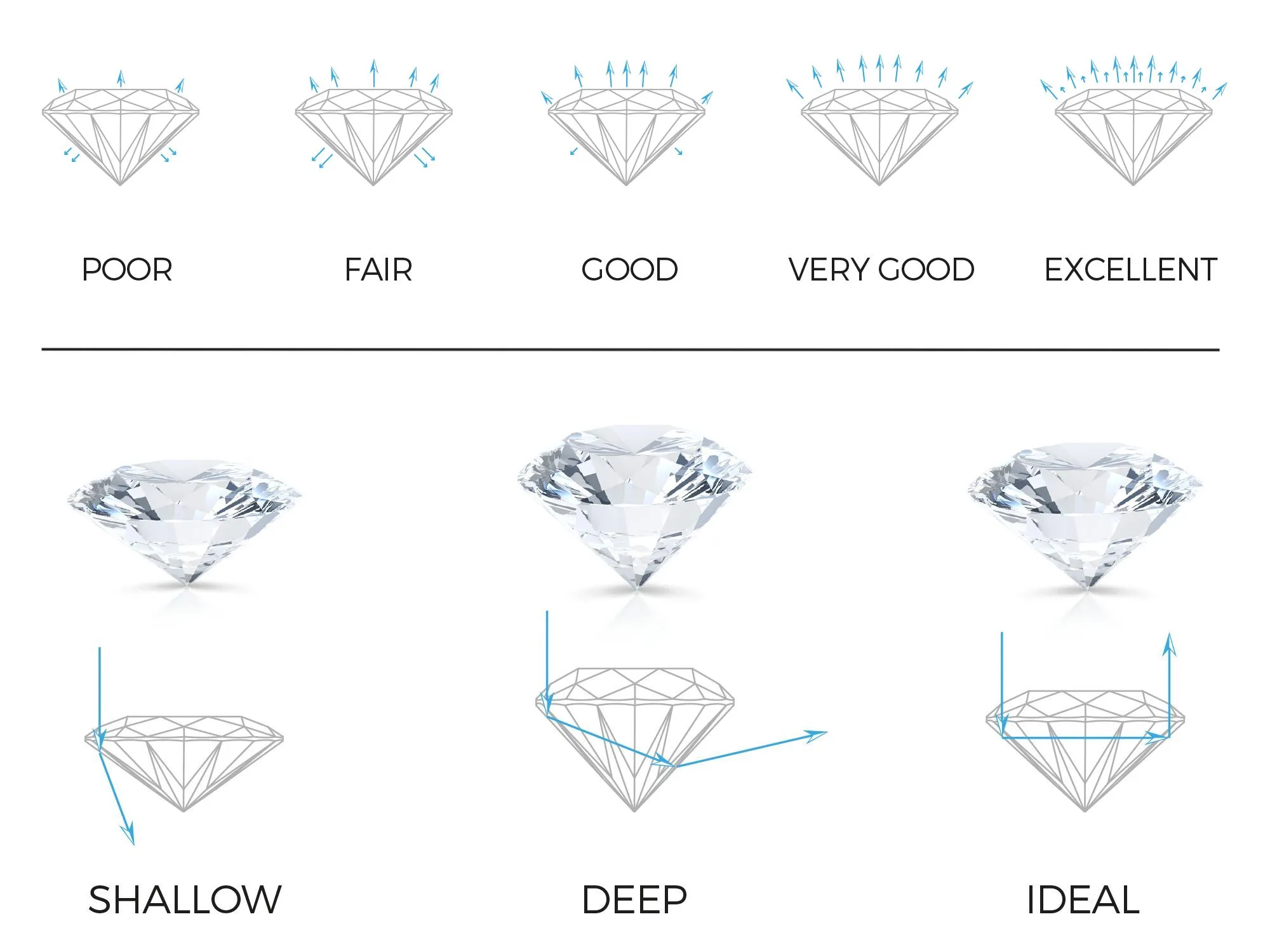The Importance of Diamond Cut
The slice of a diamond alludes to how well it has been shaped and faceted from its unpleasant form. Not at all like tone or clarity, the cut is not a physical attribute but instead a consequence of the diamond shaper’s expertise and the plan of the diamond. The quality of the cut affects how light interacts with the diamond, impacting its sparkle and overall visual appeal. While discussing types of diamond cuts, it’s essential to consider how each cut impacts the diamond’s brilliance and fire.
Round Brilliant Cut
The Round Brilliant cut is the most popular and notable of the types of diamond cuts. This cut features 58 facets that are strategically placed to maximize the diamond’s sparkle. The Round Brilliant cut is prestigious for its exceptional brilliance, making it a popular decision for engagement rings and other fine gems. Its symmetrical plan guarantees that light is reflected and refracted optimally, creating a dazzling display of fire and brilliance.
Princess Cut
The Princess cut is a square or rectangular shape with pointed corners, known for its contemporary and elegant appearance. This slice is intended to retain the diamond’s brilliance while showcasing its interesting mathematical shape. The Princess cut is a popular decision for those looking for a cutting edge alternative to the Round Brilliant cut, offering a stylish and sophisticated look. Its facets are intended to enhance the diamond’s sparkle, making it a striking choice for various types of gems.
Pad Cut
The Pad cut, also known as the Pad Brilliant, features an adjusted square or rectangular shape with softened corners. This vintage-propelled cut joins a traditional look with current brilliance. The Pad cut’s larger facets create an exceptional play of light, giving it a distinct and romantic appeal. This cut is favored for its classic charm and ability to enhance the diamond’s tone and clarity, making it an immortal decision for engagement rings and other fine pieces.
Emerald Cut
The Emerald cut is characterized by its rectangular shape with edited corners and parallel facets. Dissimilar to different cuts that emphasis on maximizing brilliance, the Emerald cut emphasizes the diamond’s clarity and variety. Its step-cut plan creates a sophisticated, linear impact that showcases the diamond’s natural beauty. The Emerald cut is ideal for the people who appreciate a classic, elegant look with an emphasis on the diamond’s clarity and understated brilliance.
Asscher Cut
The Asscher slice is similar to the Emerald cut however features a square shape with a higher crown and larger facets. This cut is known for its Art Deco style and vintage appeal. The Asscher cut’s step-cut plan creates an entrancing visual impact, often alluded to as the “hall of mirrors” impact. This cut is appropriate for the individuals who look for a special and classic look, with an emphasis on clarity and mathematical precision.
Radiant Cut
The Radiant cut consolidates the elegance of the Emerald cut with the brilliance of the Round Brilliant cut. It features a rectangular or square shape with managed corners and a brilliant-cut facet arrangement. The Radiant slice is intended to enhance the diamond’s sparkle while maintaining its mathematical shape. This cut is versatile and functions admirably in various types of gems, giving a vibrant and captivating display of brilliance.
Oval Cut
The Oval cut is an elongated variant of the Round Brilliant cut, with a similar facet arrangement yet a distinct shape. This cut offers a remarkable and elegant alternative to traditional round lab created diamonds, giving a flattering impact on the finger or setting. The Oval cut is known for its exceptional brilliance and the ability to create the deception of a larger stone because of its elongated shape. It is a popular decision for those looking for a distinctive and graceful appearance.
Marquise Cut
The Marquise cut features an elongated, boat-shaped plan with pointed closes. This cut is known for its dramatic and striking appearance, often making the diamond appear larger than its actual carat weight. The Marquise cut’s interesting shape and faceting create a beautiful play of light, enhancing its brilliance and sparkle. This cut is ideal for those searching for an intense and elegant choice that stands out.
Pear Cut
The Pear cut, also known as the Teardrop cut, joins the Round Brilliant slice with the Marquise slice to create a tear-shaped diamond. This cut offers an interesting and elegant appearance, with a sharp end and an adjusted base. The Pear cut is known for its versatility and ability to enhance the diamond’s brilliance and variety. It is a popular decision for those looking for a distinctive and sophisticated look.
Conclusion
Understanding the various types of diamond cuts can significantly impact your decision while purchasing a diamond. Each cut offers novel characteristics and visual impacts, from the classic brilliance of the Round Brilliant to the vintage charm of the Pad cut. By considering the cut’s impact on brilliance, shape, and overall appearance, you can choose a diamond that impeccably aligns with your style and inclinations. Whether you lean toward the immortal elegance of the Emerald cut or the cutting edge appeal of the Princess cut, the right cut will enhance the diamond’s natural beauty and make a lasting impression.
You may also like
-
The Allure of Lab-Grown Diamond Rings: A Modern Revolution in Elegance
-
The Truth About Loose Man Made Diamonds: A Modern Marvel in Jewelry
-
Engagement Rings for Men: A Modern Trend in Symbolizing Commitment
-
Guides to Lab Grown Diamonds: Your Ultimate Guide to Choosing the Perfect Stone
-
Lab Diamonds Are the Future: Revolutionizing the Jewelry Industry

